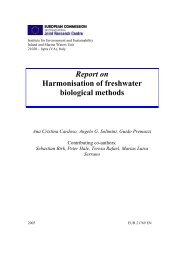Lakes and Watercourses
Lakes and Watercourses
Lakes and Watercourses
Create successful ePaper yourself
Turn your PDF publications into a flip-book with our unique Google optimized e-Paper software.
The genera in question <strong>and</strong> their trophic ranking scores <strong>and</strong> sensitivity<br />
to pollution are listed in the method description in the EPA Environmental<br />
Monitoring H<strong>and</strong>book; indices can be calculated using the<br />
Omnidia software.<br />
The class boundaries essentially reflect the state of the watercourse as<br />
follows:<br />
Class 1. Highly oligotrophic to oligotrophic state <strong>and</strong> no or insignificant<br />
pollution.<br />
Class 2. Oligotrophic to eutrophic state <strong>and</strong>/or slight pollution.<br />
Class 3. Eutrophic to highly eutrophic state <strong>and</strong>/or obvious pollution.<br />
Class 4. Severe pollution.<br />
Class 5. Very severe pollution.<br />
This classification is based on European studies <strong>and</strong> have been<br />
adapted to Swedish conditions in terms of pollution levels <strong>and</strong> algal<br />
occurrence. It has been tested on limited Swedish data from various<br />
ecotypes.<br />
Assessment of deviation from reference values<br />
There is no background data from which to determine reference values<br />
<strong>and</strong> therefore no proposed assessment of deviation is described here.<br />
Comments<br />
Experience in Sweden of water quality assessment using diatoms is<br />
limited <strong>and</strong> the model criteria in this chapter are therefore largely based<br />
on experience in other countries. Class boundaries <strong>and</strong> other aspects may<br />
be adjusted as more is learnt about Swedish conditions.<br />
The assessment must be based on samples taken <strong>and</strong> analyses made in<br />
accordance with the Swedish EPA Environmental Monitoring H<strong>and</strong>book<br />
<strong>and</strong> analyses made in accordance with the Swedish st<strong>and</strong>ard.<br />
References<br />
Jarlman, A. & Bengtsson, R. (1999): Påväxt – kiselalger (”Periphyton - diatoms”). –<br />
From: T. Wiederholm (Ed.). Bedömningsgrunder för miljökvalitet – Sjöar och vattendrag.<br />
Bakgrundsrapport 2 - Biologiska parametrar (”Environmental Quality Criteria<br />
– <strong>Lakes</strong> <strong>and</strong> <strong>Watercourses</strong>. Background report 2 – Biological parameters”).<br />
Swedish EPA Report 4921.<br />
Lecointe, C., Coste, M. & Prygiel, J. (1993): ”Omnidia”: software for taxonomy,<br />
calculation of diatom indices <strong>and</strong> inventories management. – Hydrobiologia<br />
269/270:509-513.<br />
64















![Accommodation booking form [PDF]](https://img.yumpu.com/39471785/1/184x260/accommodation-booking-form-pdf.jpg?quality=85)

